
The Aladdin Deck Enhancer is a system-enhancing adaptor to use Compact Cartridges on the Nintendo Entertainment System. It was produced by Camerica and developed by Codemasters but not licensed by Nintendo. It is similar to the Datach system for the Famicom, but without the Barcode feature. It was released in November 1992, with its planned library to reach a total 24 games by the end of 1993. However, only seven games were actually released. The device had low sales and Camerica went bankrupt in 1993.

The Great Giana Sisters is a platform game developed by the West German company Time Warp and published by Rainbow Arts in 1987 for home computers such as the Commodore 64, Amiga and Atari ST. Players control Giana to explore a magical world inside their dreams; to wake up, they must find a giant diamond. They traverse side-scrolling stages while avoiding hazards such as monsters and other enemies. These can be defeated by using power-ups, which grant the player abilities such as firing projectiles and making enemies fall asleep.
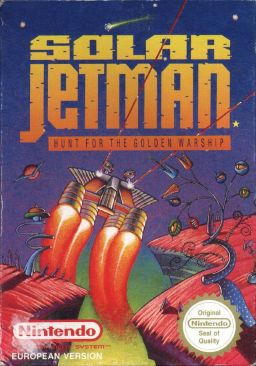
Solar Jetman: Hunt for the Golden Warpship is a multidirectional shooter video game developed by Zippo Games and Rare and published by Tradewest for the Nintendo Entertainment System. It was released in North America in September 1990 and in Europe by Nintendo on 26 September 1991. The game is the third installment of the Jetman series and was later re-released by Nintendo for their NES-based PlayChoice-10 arcade system in the United States in 1990.
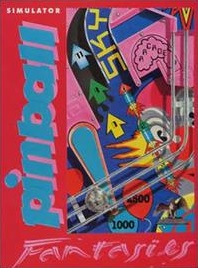
Pinball Fantasies is a 1992 pinball video game originally developed by Digital Illusions and published by 21st Century Entertainment in Europe for the Amiga home computers. It is the sequel to Pinball Dreams, which was released earlier in the same year on multiple platforms. In the game, players can choose between any of the four available playfields, both of which have their own thematic and main objectives in order to obtain the highest score possible.

Top Gear is a racing game for the Super Nintendo Entertainment System, published by Kemco and developed by Gremlin Graphics in 1992. The objective of the game is to become the fastest driver in the world by racing other drivers across several nations.
Ocean Software Ltd was a British software development company that became one of the biggest European video game developers and publishers of the 1980s and 1990s.

Factor 5 GmbH is an independent software and video game developer. The company was co-founded by five former Rainbow Arts employees in 1987 in Cologne, Germany, which served as the inspiration behind the studio's name.
1992 saw many sequels and prequels in video games, such as Dragon Quest V, Final Fantasy V, Sonic the Hedgehog 2, Street Fighter II: Champion Edition, Super Mario Land 2: 6 Golden Coins, and Super Mario Kart, along with new titles such as Art of Fighting, Lethal Enforcers, Mortal Kombat and Virtua Racing.

Turrican is a 1990 video game developed by Manfred Trenz. It was developed for the Commodore 64 by Rainbow Arts, and was ported to other systems later. In addition to concept design and character creation, Trenz programmed Turrican on the Commodore 64. A sequel, Turrican II: The Final Fight, followed in 1991 for the Commodore 64 and other platforms.

Krusty's Fun House is a puzzle video game based on the animated sitcom The Simpsons.

Axelay is a 1992 scrolling shooter video game developed and published by Konami for the Super Nintendo Entertainment System. Set in the fictional solar system Illis where an alien empire known as "Armada of Annihilation" invades its planets including the Earth-like Corliss (Mother), players take control of the titular D117B space fighter craft as a last resort to stop the alien invasion by recovering its lost weaponry. The gameplay mainly consist of both vertical-scrolling and horizonal-scrolling stages in the same vein as Konami's own Life Force, with players choosing three different weapon-types that increase in number as they progress through the game.

Total Carnage is a multidirectional shooter arcade video game originally developed and published by Midway in North America in January 1992. Set in the fictional country of Kookistan during 1999, players assume the role of Captain Carnage and Major Mayhem from the Doomsday Squad in a last-ditch effort to overthrow dictator General Akhboob and his army of mutants from conquering the world, while also rescuing POWs held by his military force.
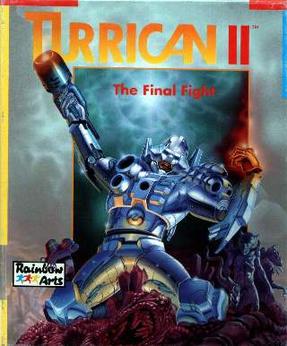
Turrican II: The Final Fight is the second game of the Turrican series. The game, developed by Factor 5 was released in 1991 for the Commodore Amiga. This version was finished before the C64 version, but Manfred Trenz cites the C64 version as the original design. Turrican II was also released for the CDTV, Atari ST, Amstrad CPC and ZX Spectrum, and later for DOS, and also for the Mega Drive/Genesis and Game Boy rebranded as Universal Soldier.
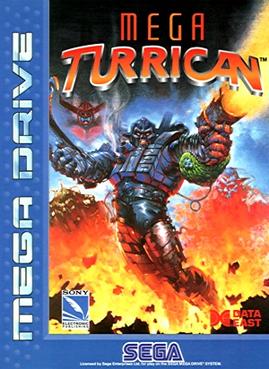
Mega Turrican is a run and gun video game, developed by Factor 5 in 1993 and marketed by Data East in 1994. Part of the Turrican series, it was designed for the Mega Drive/Genesis, and later followed by an Amiga port converted by Kaiko and Neon Studios under the title of Turrican 3: Payment Day. Despite not being the original, the Amiga version was the one that was first commercially released in 1993, published by Rainbow Arts in Germany and Renegade in the rest of Europe. The Mega Drive version did not have a publisher and stayed unreleased from spring 1993 until 1994, when Data East took over its worldwide distribution. Data East itself released the game in North America, and contracted Sony Imagesoft for the game's distribution in Europe.

Konami Hyper Soccer is a 1992 soccer video game developed and published by Konami in Europe and Australia for the Nintendo Entertainment System. Part of the Hyper Sports series, which included Hyper Olympic, its sequel Hyper Sports and Hyper Athlete, it is the second soccer game by Konami following Konami's Soccer on the MSX, and their first soccer game on a Nintendo platform.

Katakis is a horizontally scrolling shooter developed for the Commodore 64 by Rainbow Arts in 1987, and converted to the Amiga by Factor 5 in 1988. It was re-released as Denaris in 1989. The name Katakis has a Greek origin and was found in a phone book in Gütersloh, Germany. The name Denaris was created by a random name generator, and by coincidence, matches a Greek name as well.

Rendering Ranger: R2 is a 1995 side scrolling action video game developed by Rainbow Arts and published by Virgin Interactive for the Super Famicom. It was released only in Japan, and has gone on to be one of the rarest Super Famicom titles in existence. In June 2022, Ziggurat Interactive announced that the game would be ported to Microsoft Windows, Nintendo Switch, PlayStation 4, and PlayStation 5, with Limited Run Games set to distribute physical copies for the Super Nintendo Entertainment System.
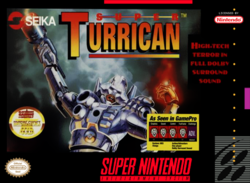
Super Turrican is a run and gun video game and the fifth game in the Turrican series. It was released for the Super Nintendo Entertainment System in 1993. Super Turrican was released on the Virtual Console in Europe and Australia on February 29, 2008, and in North America on March 3, 2008.
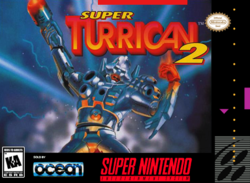
Super Turrican 2 is a 16-bit shooter game for the Super Nintendo Entertainment System, developed by Factor 5 and marketed by Ocean Software in 1995. Part of the Turrican series, it is the sequel to Super Turrican for the same platform.

The Analogue Super Nt is an FPGA-based home video game console designed and manufactured by Analogue. It is designed to be compatible with games for the Super Nintendo Entertainment System.


















